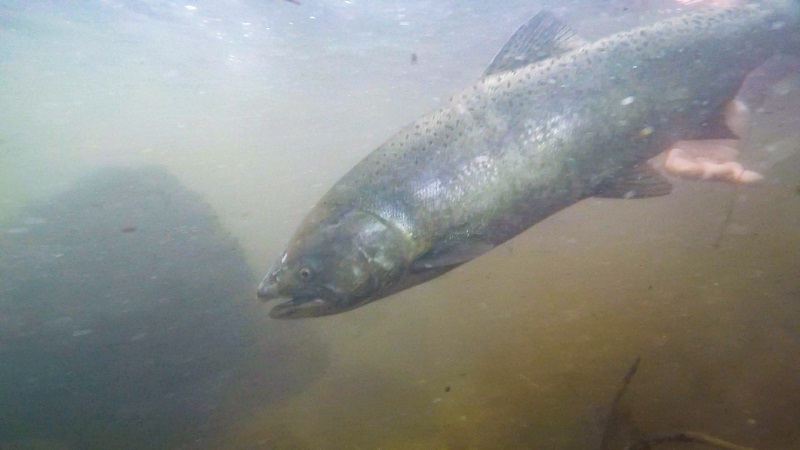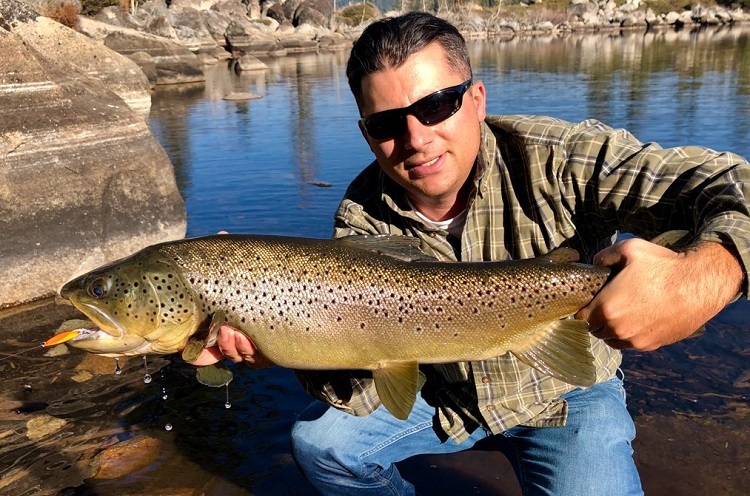Endangered California Salmon Returned to Safer Waters After More than A Century

by California Department of Fish & Wildlife
5-6-2022
Website
*** A Joint News Release Issued by the California Department of Fish and Wildlife; the U.S. Fish and Wildlife Service; and the Bureau of Reclamation***
State and federal biologists have begun moving threatened spring-run Chinook salmonto Clear Creek in northern California, where colder water temperatures will better support spawning and help their eggs survive the continuing drought.
Teams from the California Department of Fish and Wildlife (CDFW) and the U.S. Fish and Wildlife Service (USFWS) are relocating the fish. Together, they will return about 300 adult winter-run Chinook salmon to native habitat above Eagle Canyon Dam on North Fork Battle Creek, about 20 miles east of Cottonwood, in Shasta and Tehama counties for the first time in more than 110 years.
Pacific Gas and Electric (PG&E), which operates hydroelectric facilities on Battle Creek, coordinated operations to make the move possible. It is one of a series of urgent actions to help the native fish survive another year of the lasting drought and high temperatures, thiamine deficiency, predators and other stressors that devastated the population the last two years in the Sacramento River below Shasta and Keswick dams.
Agencies Join Forces
CDFW, USFWS, NOAA Fisheries, Bureau of Reclamation, the California Department of Water Resources and water users are coordinating efforts to save the state and federally protected species. The agencies are working closely with the Winnemem Wintu Tribe, whose culture is intertwined with salmon in the area. Other actions include:
- Managing releases of limited water stored in Shasta Reservoir into the Sacramento River, where additional spawning gravel has been placed, to improve the odds that the released water is cool enough to allow some Chinook salmon eggs in the river to survive.
- Expanding production of juvenile, winter-run Chinook salmon at Livingston Stone National Fish Hatchery operated by the USFWS at the base of Shasta Dam. Offspring produced at the hatchery in recent years have helped save the species as most of their eggs in the wild have died. Juvenile fish will be released into the river in stages when conditions are more hospitable in the late fall and winter.
- Moving adult spring-run Chinook salmon that return up the Sacramento River to the upper reaches of Clear Creek in Shasta and Siskiyou counties to cooler water and increased chances of egg survival.
- Boosting the resilience of transported adult salmon with injections of thiamine (Vitamin B) to counter a deficiency that researchers believe has depressed survivalof their offspring in recent years. The deficiency has been tied to shifting ocean conditions and salmon feeding primarily on anchovies compared to a more diverse diet of forage fish, krill and other species.
- Tracking the survival and reproduction of the transported fish as part of a science plan to learn from these actions to promote climate resilience of Chinook salmon. Research includes field studies to understand the productivity of historic habitat where winter-run Chinook salmon will be reintroduced.
The transport of adult winter-run Chinook salmon to upper Battle Creek builds on the “jumpstart” reintroduction program that began in 2018 with annual releases of juvenile salmon in lower reaches of the creek. Many of the released fish migrated to the ocean and have returned as adults to spawn, demonstrating that Chinook salmon can reestablish themselves given habitat that remains cool enough for their eggs to survive the summer.
Hydroelectric facilities and natural barriers prevent the adult salmon from reaching the cool, spring-fed waters in the upper portions of North Fork Battle Creek some 3,000 feet above the Sacramento Valley floor. Juvenile offspring of the transported adults that hatch in the creek are expected to be able to swim downstream past Eagle Canyon Dam and reach the Sacramento River.
Returning Above Shasta
State and federal salmon recovery plans also call for returning winter-run Chinook salmon to historical spawning habitat in the McCloud River above Shasta Dam and Reservoir. That requires a means of collecting juvenile salmon that hatch and try to swim downriver toward the ocean and need to safely get past the 600-foot high Shasta Dam. Agencies plan to test a pilot juvenile collection system this fall.
These efforts are part of a comprehensive program in the Sacramento Valley to address all freshwater life cycle stages to benefit all four runs of Chinook salmon in the region. Work will continue this year to advance science through the Sacramento River Science Partnership and to implement projects in the downstream reaches of rivers and creeks to create additional spawning habitat, side channel rearing habitat, fish food and migration barrier removal.
These efforts are also part of a longer term recovery effort underway to address climate change and provide greater resilience for salmon by expanding access to important habitat and landscapes, including reintroduction for spawning and rearing above Shasta Dam and Reservoir, spawning in the upper reaches of Battle Creek, and food sources and safe haven in the bypasses, oxbows and historic floodplain in the lower part of the system.
Comments from Agency Leaders
“The historic reintroduction of adult, winter-run Chinook salmon into the North Fork Battle Creek this spring will help secure another generation of this imperiled iconic species. This reintroduction – combined with long term efforts to restore the Battle Creek watershed and establish a second population of winter-run beyond the Sacramento River – means we are helping this species to become more climate resilient and drought resilient for a brighter future.”
Paul Souza, Pacific Southwest Regional Director for the U.S. Fish and Wildlife Service
“This marks the first time in many years that anadromous fish have been in upper Battle Creek. Releasing salmon to this location is critical during this third year of drought because water temperatures are cooler and habitat is more conducive to spawning. This action would not be possible without the support of the Battle Creek Salmon and Steelhead Restoration Projects, a collaborative effort between state, federal and private agencies.”
Ernest Conant, Regional Director of the Bureau of Reclamation
“Strong collaboration is key to managing the limited resources we have to work within the Sacramento River Basin this third consecutive drought year. Together, we are taking unprecedented actions to increase salmon productivity during one of the driest years on record.”
Jan Nimick, PG&E Vice President of Power Generation
“PG&E recognizes the current critical situation for adult winter-run salmon this year and are pleased to be working with the agencies to coordinate our project operations where we can to support a successful movement of salmon to colder water to support this urgent action by the agencies.”
Photos and video of the salmon relocation and release into North Fork Battle Creek and Clear Creek are available for download and use at the following FTP link.
###
About the California Department of Fish and Wildlife
The mission of the California Department of Fish and Wildlife is to manage California’s diverse fish, wildlife, and plant resources, and the habitats upon which they depend, for their ecological values and for their use and enjoyment by the public. To learn more, visit www.wildlife.ca.gov. Connect with us at Facebook, Twitter, Instagram, and YouTube.
About the U.S. Fish and Wildlife Service
The U.S. Fish and Wildlife Service works with others to conserve, protect, and enhance fish, wildlife, plants, and their habitats for the continuing benefit of the American people. For more information about our work and the people who make it happen, visit https://www.fws.gov/cno/ or connect with us via Facebook, Twitter, YouTube, and Flickr.
About the Bureau of Reclamation
The Bureau of Reclamation is a federal agency under the U.S. Department of the Interior and is the nation's largest wholesale water supplier and second largest producer of hydroelectric power. Its facilities also provide substantial flood control, recreation opportunities, and environmental benefits. Visit www.usbr.govand follow @USBR & @ReclamationCVP on Twitter; Facebook @bureau.of.reclamation; LinkedIn @Bureau of Reclamation; Instagram @bureau_of_reclamation; and YouTube @reclamation.
Media Contacts:
Peter Tira, CDFW, (916) 215-3858
John Heil, U.S. Fish and Wildlife Service, (916) 414-6636
Mary Lee Knecht, Bureau of Reclamation, (916) 978-5101
More Reports

5-3-2022
The California Department of Public Health (CDPH) announced the annual quarantine of sport-harvested mussels gathered along the California coast. The...... Read More

4-28-2022
The traditional trout season opener the last Saturday in April remains one of California’s most celebrated and anticipated outdoor traditions,...... Read More
